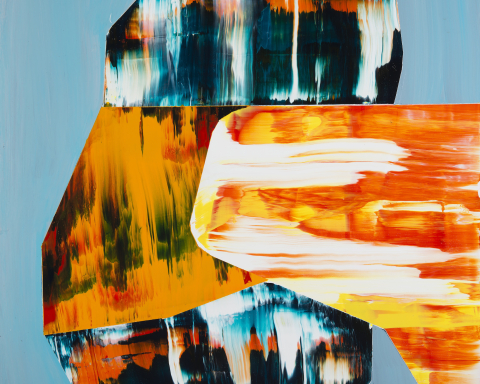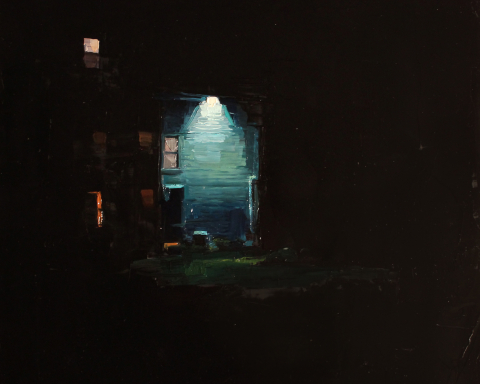There is something distinctly present about Nathanael Flink’s paintings, a feeling they evoke that distinguishes them from other colorful abstractions. Like excavated fossils, they are the enduring impressions of life-cycles, evidence of the age from which they have emerged. The uneven edges, crooked marks and weather-beaten veils of color come together in a simultaneously haphazard and harmonious synthesis of diverse methods. Ostensibly, they are suspended moments. Within the confines of the stretched linen, the artist’s stains and streaks have settled and congealed like the byproducts of an inexplicable passage.
Flink’s compositions have the potential to engulf the viewer in their opposing layers of space. What appear to be the trademark strokes of a color field painter are actually impressions of an indistinguishable source. Like an imprint left in the grit of the sidewalk, layered beneath a shadow cast by an adjacent chain-link fence, Flink’s paintings are crowded with complex visual potential and filled with a tension, a dialogue that beckons the viewer to look into and through the world of the painting. But here we do not find ourselves waist deep in rich pigment, as in a Rothko, or lost in the lush and teaming landscape of a Lundsager; rather, the paintings leave you floating in a void that is nevertheless brimming with a peculiar kinetic energy.
Flink’s objective isn’t to trump other veteran abstractionists. In the post-modernist world, where the boundaries of painting have been pushed to their respective extremes, artists are no longer tasked with testing the absolute limits of art or challenging the latest avant-garde trend. The freshness of Flink’s paintings has nothing to do with their shock factor; in lieu of a premeditated execution of “newness,” Flink invests himself in a visceral, automatistic undertaking. A large part of his artistic practice takes place in the space between the grill and the flowerbeds, on the ground of his back yard. He works in fits and spurts, indifferent to the lighting conditions, and employs an eccentric array of found objects – wood scraps, wire hangers, mesh and feather dusters – in addition to his own custom-made rollers and makeshift painting instruments.
Flink pairs his newfangled tools with elements that he is unable to predict the consequences of in order to make room for unexpected growth and discovery. He thus makes his panels to be sturdy enough to withstand an impending onslaught. After laying down marks and blocks of color, Flink will often smear and scrub his paintings and blast them with a hose. The visual phenomenon of the process itself grants an almost childlike joy, a natural excitement that comes with bearing witness to the pigments pooling and swirling on the surface of the panels.
By attacking and baptizing the panels, new worlds unfurl, and the continuous process of construction and deconstruction gives them a sense of history and depth. But despite the use of organic elements, the environments within the paintings are not naturalistic but markedly 21st century; Flink’s delineations and their relation to the edge prevent a reading of a true landscape. And while the panels are loaded with pigment and structure, there is an immaterial quality to the spaces, like computing “clouds” crowded with data. One feels he may have the ability to reach inside the panel, but has no capacity to grip. Even in works like “Shroud” where flat, graphic shapes are reiterated and smeared across the ground, the forms feel more like fleeting images caught in a strobe light than actual figures.
In a discussion with the artist, Flink credited Minneapolis College of Art and Design professor David Nye Brown, as being one of his greatest mentors, and noted his interest with a paradigm which Brown calls the state of “being and becoming” – the concept that we are simultaneously engaged in the process of becoming ourselves and of being ourselves in the world. Flink’s painting process entices his audience to acknowledge this paradigm as it exists within art. The spirit of his works are not just in their being – i.e., their present state – but in their becoming as well. His active process lends equal significance to the history of the paintings and to their present existence as individual works of art. The rugged stains, streaks and bruises on the panels thus become enticing clues into the mystery of the painting’s origins.
If one takes their inspection into the history of the works even further, there is Flink’s own dense narrative to unwind. Here the notion of “being/becoming” presents itself again – this time in relation to the artist and his art. The artist’s “becoming” – Flink’s progression from figuration, to collage, to landscape, to dark room experimentation – is a web riddled with cultural and art historical references spanning from cave painting to computer science.
Though his impulse to create “happy accidents” is palpable in the raw and otherworldly fog of his paintings, his prior visual investigations are nevertheless imbued in every decision of his exploration. Even when he gives up control, the act is purposeful and temporary, and Flink’s abstract worlds thusly become documentations of thoughtfully lived experiences where creation and destruction are one in the same. Like the mouth of the Grand Canyon, we cannot separate the end product from the erosive process that led to its existence. In the aftermath of this battle between certainty and uncertainty, Nathaneal Flink’s paintings become both an entry point into felt space, and a catalyst for art historical dialogue.
Juliet Silveira, Critic-at-large Brooklyn, NY











